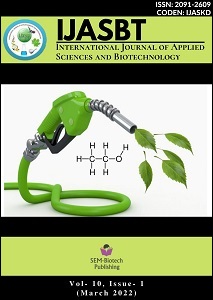An Improved Amperometric Lactose Biosensor Based on Enzyme Nanoparticles
DOI:
https://doi.org/10.3126/ijasbt.v10i1.44155Keywords:
Lactose, β-galactosidase nanoparticles, Glucose oxidase nanoparticles, Enzyme nanoparticles, Au electrode, Lactose biosensorAbstract
A desolvation method was used for the synthesis of β-galactosidase (β-GAL) and glucose oxidase (GOD) nanoparticles (NPs) using ethanol. The enzyme nanoparticles (ENPs) were characterized by transmission electron microscopy (TEM) and Fourier transform Infra-red spectroscopy (FTIR) and were co-immobilized covalently onto surface of polycrystalline Au electrode. An improved amperometric lactose biosensor was constructed using ENPs (β-GALNPs/GODNPs) modified Au electrode as working electrode, Ag/AgCl as reference electrode and Pt wire as auxiliary electrode connected through potentiostat. Cyclic voltammetry (CV) and scanning electron microscope (SEM) were used for the study of working electrode before and after immobilization of ENPs. The biosensor showed maximum current at 0.25V within 5s, at pH 6.5 and 25oC. The limit of detection (LOD) was i.e. 1mg/ml and working range was 1-10 mg/mL. The analytical recovery of added lactose (5 and 10 mg/mL) was 94.73±0.5% and 96.4±0.9%, respectively. Coefficient of variation (CV) within and between batch were <3.0 and <4.0 respectively. The biosensor exhibited a good correlation (R2=0.91) between lactose level in milk as measured by standard (enzymatic colorimetric) method and present biosensor. The biosensor was employed for quantification of lactose in milk from human, cow, buffalo and goat. The working electrode lost 50% of its initial activity within 3 months, after its 120 uses, while being stored dry at 4ºC.
Int. J. Appl. Sci. Biotechnol. Vol 10(1): 21-30.
Downloads
Downloads
Published
How to Cite
Issue
Section
License
Copyright (c) 2022 International Journal of Applied Sciences and Biotechnology

This work is licensed under a Creative Commons Attribution-NonCommercial 4.0 International License.




